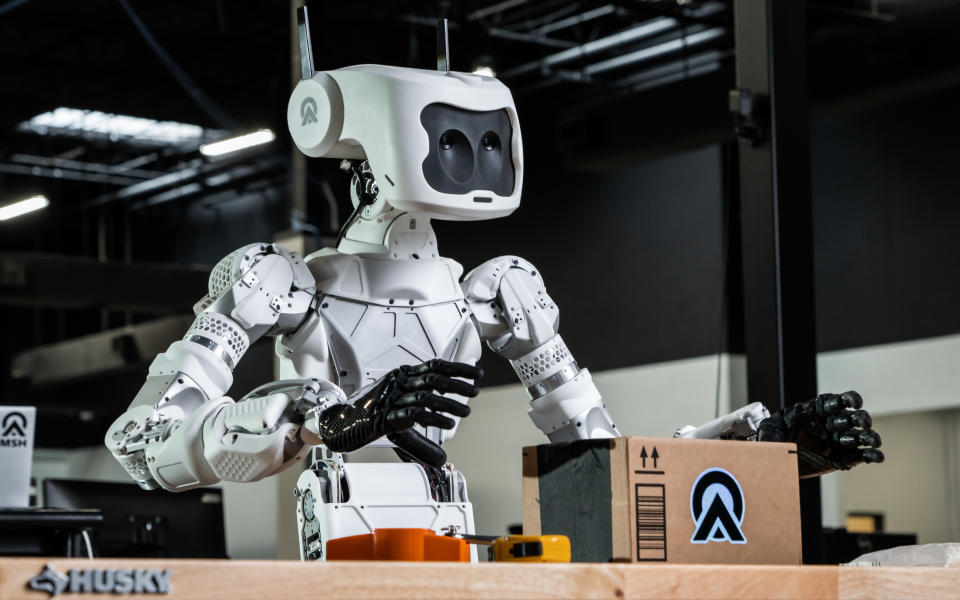Are general-purpose robots impossible? Apptronik says no, pockets fresh NASA partnership
Robotics has made great strides in even just the last five years. But despite major advances in core technology such as sensing and computing, many of the robots populating industries like manufacturing are considered "special purpose": they are engineered to perform a limited number of tasks in stable, predictable environments. It’s not uncommon to encounter the opinion that, whatever leaps and bounds robotics may have progressed, a general-purpose robot (GPR) — one that can perform a range of tasks in an uncertain environment — is still just a pipe dream.
Austin-based Apptronik disagrees. The company has already designed an upper-body humanoid robot called Astra, which it says is a GPR that can perform tasks like stocking, packaging and other functions common in industrial settings. Now, Apptronik is preparing to commercialize another robot, which it also says is a GPR, designed for heavier payloads and more critical industries, including aerospace, logistics and retail. Apptronik calls this second humanoid “Apollo,” and the company recently landed a new contract with NASA to bring it to market next year.
One might wonder why we don’t just put an AI into an excavator or any other type of robot — after all, we’re designing autonomous vehicles, rather than robots that are really, really good at driving cars. But Apptronik co-founder and CEO Jeff Cardenas says there’s room for both. He added that human-shaped robots are best-suited to operate in environments designed for humans, and to use all the same tools that humans use.
“Traditional robots are really designed to do highly repeatable things in structured environments,” Cardenas said. “What we've been really focused on is, how do we build robots that can operate in highly variable dynamic environments? With the humanoid robot, it's really, how can we build a robot that's made by humans, for humans, to work in spaces that were designed for humans?”
He and CTO and co-founder Nick Paine likened GPRs to smartphones, which have a range of functions. In this case, Apollo is the hardware-and-software platform that can perform different tasks or create different applications. Its end-effectors will be swappable, so it can have humanoid hands, but also grippers, pinchers or other manipulators. And it will be able to move roughly at the same speed as a human, Apptronik says.
“We're building a platform,” Paine explained. “You don't need M/L frameworks to build iPhone apps, you need a scalable hardware platform that can perform a wide range of tasks.”
Cardenas said that while it’s still early days, we’re shifting from an old world populated entirely by special-purpose robots to a new world of GPRs: robots that can even learn, imitate and get better at its tasks the longer it performs them, capabilities that Apptronik says it is planning to roll out over time. The level of abstraction will increase, too; initially, Apollo will be controlled through a user interface on a smartphone or computer, and the customer will have to be pretty specific about what she wants Apollo to do. But the end goal is to be able to give Apollo high-level tasks that it can figure out how to accomplish on its own.
While there will still be a place for special-purpose robots, Cardenas said we are very much arriving at a new stage of robotics that science fiction promised.

The Astra robot. Image Credits: Apptronik (opens in a new window)
GPRs for Earth and beyond
The company’s relationship with NASA extends as far back as 2013, when the team participated in the DARPA Robotics Challenge and was selected to work on a robot called Valkyrie. At that point, Apptronik was still part of the Human Centered Robotics Lab at the University of Texas at Austin (it spun out from the lab in 2016). That team included Paine and Luis Sentis, who also founded the company and now acts as scientific advisor.
“You can really think of Apptronik as the commercialization of all the work that was done at NASA, with DARPA,” Cardenas said.
Apollo is an auspicious name for a robot with NASA support behind it. In Greek mythology, Apollo was the twin brother of Artemis; and Artemis is the name NASA has chosen for its ultra-ambitious, multiyear plan to establish a permanent human presence on the moon. As the partnership with NASA indicates, the company is thinking about how GPRs could benefit humans in space — on the moon, or even Mars. Plus, Cardenas said, having robots that can walk around and fit into the same interior footprint as a human could be very handy for a settlement on Mars.
Before Apollo ever sees space, Apptronik is eyeing terrestrial applications, with the hopes of selling the robot to companies across major industries. The company, which raised $14.6 million in seed funding earlier this summer in part to fund this commercialization effort, is hoping to showcase the robot at South by Southwest next year.
The company has around 62 full-time staff, and it’s been hiring since the close of its seed round. It’s staying silent for now about the pricing of an Apollo robot, but Cardenas said that by iterating on dozens of unique actuators — one of the costliest parts of the system — they’ve been able to make them more affordable. The end goal is to deliver a million robots by 2030.
“A lot of people are skeptical of this technology,” Cardenas said. “[They say,] ‘Is this real? Is it here?’ What we believe is, by partnering with NASA, which is this storied group that’s known for real technology and really pushing things forward, that’s really showcasing an inflection point in robotics. The time is now, and we’re at this new stage of robotics where we can now build new types of systems that a lot of people have waited a long time for.”


